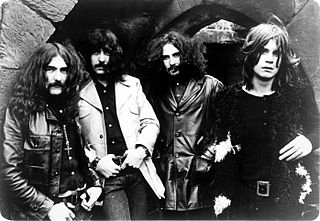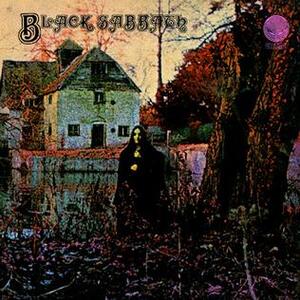
Black Sabbath were an English rock band formed in Birmingham in 1968 by guitarist Tony Iommi, drummer Bill Ward, bassist Geezer Butler and vocalist Ozzy Osbourne. They are often cited as pioneers of heavy metal music. The band helped define the genre with their first three albums Black Sabbath (1970), Paranoid (1970) and Master of Reality (1971). Following Osbourne's departure in 1979, the band underwent multiple line-up changes, with Iommi being the only constant member throughout their history.

John Michael "Ozzy" Osbourne is an English musician and media personality. He rose to prominence during the 1970s as the lead vocalist of the heavy metal band Black Sabbath, during which period he adopted the nickname "Prince of Darkness".

Paranoid is the second studio album by English heavy metal band Black Sabbath, released on 18 September 1970 by Vertigo Records in the United Kingdom and on 7 January 1971 by Warner Bros. Records in the United States. The album contains several of the band's signature songs, including "Iron Man", "War Pigs" and the title track, which was the band's only Top 20 hit, reaching number 4 on the UK charts.

Master of Reality is the third studio album by English heavy metal band Black Sabbath, released in August 1971 by Vertigo Records. It is regarded by some critics as the foundation of doom metal, stoner rock, and sludge metal. Produced by Rodger Bain, who also produced the band's prior two albums, Master of Reality was recorded at Island Studios in London from February to April 1971. Guitarist Tony Iommi and bassist Geezer Butler downtuned their instruments during the production, achieving what Iommi called a "bigger, heavier sound".
"War Pigs" is an anti-war protest song by English heavy metal band Black Sabbath, released in 1970. It is the opening track from the band's second studio album Paranoid (1970).

Black Sabbath is the debut studio album by English heavy metal band Black Sabbath, released on 13 February 1970 by Vertigo Records in the United Kingdom and on 1 June 1970 by Warner Bros. Records in the United States. The album is widely regarded as the first true heavy metal album, and the opening track, "Black Sabbath", has been referred to as the first doom metal song.

Sabotage is the sixth studio album by English heavy metal band Black Sabbath, released on 28 July 1975. The album was recorded in the midst of a legal battle with the band's former manager, Patrick Meehan. The stress that resulted from the band's ongoing legal woes infiltrated the recording process, inspiring the album's title. It was co-produced by guitarist Tony Iommi and Mike Butcher.

"Iron Man" is a song by English heavy metal band Black Sabbath, released in 1970 from the band's second studio album, Paranoid and as a single in the US in October 1971.

"Paranoid" is a song by English heavy metal band Black Sabbath, released in 1970 off the band's second studio album, Paranoid (1970). It is the first single from the album, while the B-side is the song "The Wizard". The song is widely regarded as one of the greatest heavy metal songs of all time. It reached number 4 on the UK Singles Chart and number 61 on the US Billboard Hot 100.
"Changes" is a ballad by Black Sabbath. It first appeared on Vol. 4, which was released in 1972.
"Fairies Wear Boots" is a song by the English heavy metal band Black Sabbath, appearing on their 1970 album Paranoid. It was released in 1971 as the B-side to the single "After Forever".
"Into the Void" is a song by British heavy metal band Black Sabbath, released in 1971 on their album Master of Reality. An early version of "Into the Void" called "Spanish Sid" was released on the deluxe edition of Master of Reality. It is written in the key of C♯ minor.
"Hole in the Sky" is a song by the English heavy metal band Black Sabbath. It is the opening track on their sixth studio album, Sabotage, released in 1975.
"Symptom of the Universe" is a song by English heavy metal band Black Sabbath from their 1975 album Sabotage.
"Children of the Sea" is a song by heavy metal band Black Sabbath, from their ninth studio album, Heaven and Hell (1980).

The Collection is a compilation album released by English heavy metal band Black Sabbath in 1992. The album was released on the label Castle, who released two CD versions of this album in the UK, both with the same cover art and songs. The album includes greatest songs of Black Sabbath with Ozzy Osbourne prior to his dismissal in 1979, from the eponymous album to Never Say Die!. The album has 15 tracks, two from Black Sabbath, two from Paranoid, one from Master of Reality, two from Black Sabbath Vol. 4, two from Sabbath Bloody Sabbath, two from Sabotage, two from Technical Ecstasy and two from Never Say Die!.

"God Is Dead?" is a song by English heavy metal band Black Sabbath, the second track on their nineteenth studio album, 13 (2013). It was released as the album's lead single on 19 April 2013, the first Black Sabbath release with Ozzy Osbourne since "Psycho Man" and "Selling My Soul" from Reunion (1998).

"End of the Beginning" is a song by English metal band Black Sabbath, the opening track on their nineteenth studio album, 13 (2013).

The End is an extended play by English heavy metal band Black Sabbath and is their final release as a band. It was released on 20 January 2016. The exclusive, limited-edition CD was only available for purchase at tour dates for their final tour The End Tour. The first half of the album is leftover tracks from the 13 sessions and the second half is live tracks recorded on tour between 2013 and 2014.












